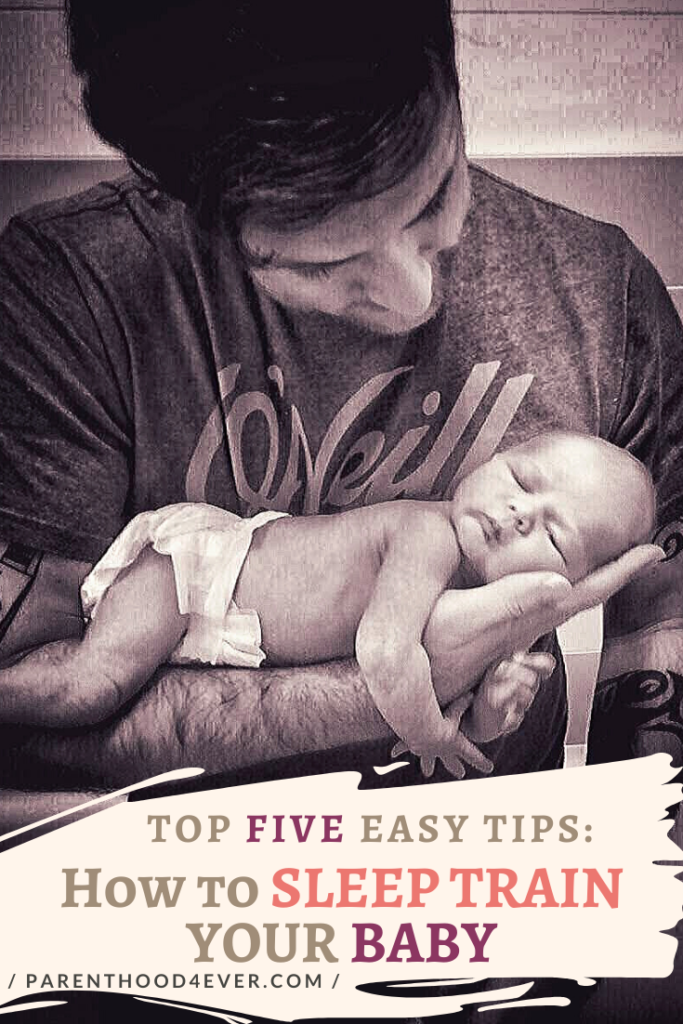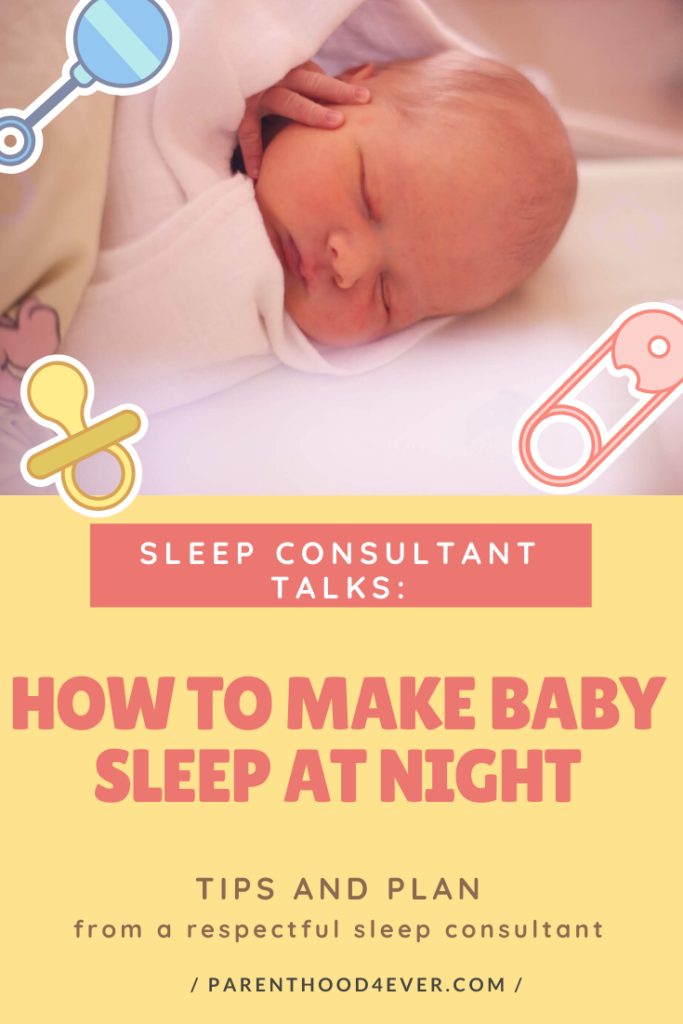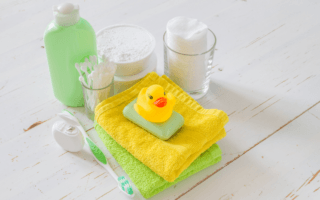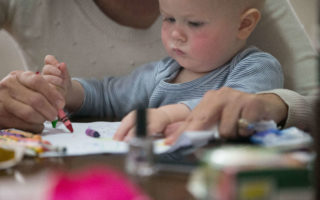“The Cry-It-Out (CIO) vs. non-CIO debate has been around forever, and always will be. Everybody is entitled to their own opinion on how to make baby sleep at night, but it’s worth researching both sides in order to have an educated opinion”, says the sleep consultant. “It is obvious that the bulk of the “research-based” evidence toted by the anti-CIO advocates is highly skewed, and sometimes just plain inaccurate, and not even performed on humans! Every parent has a different set of philosophies, of beliefs, and what works for one family does not necessarily work for the next. But if you are facing the decision of whether to sleep train your child, please do your own research and come to your own conclusions about whether or not this is harmful to your child. While Cry It Out method is not the only way to teach a child to sleep, it’s important for you to feel confident in whatever method you choose.”
Below are just a few sleep techniques that every parent might find useful for their gentle sleep training. Check our absolutely amazing guideline here on how to get your baby to sleep through the night avoiding drastic actions.
Ongoing childhood stress is bad for the brain. Letting your baby cry to teach them self-settling skills in an otherwise rich and loving environment is NOT “ongoing childhood stress”. Whatever sleep training methods we use, there will be some crying. Every parent before starting should get some patience.
1. Baby sleep environment
- You want to ensure that your baby’s sleeping environment is conducive to sleep. His room should be an 8 to 10 on a scale of bright and sunny to pitch black at naptime and at bedtime.
- White noise for baby naps and nights is great, if your baby is a very light sleeper and woken by noises around the house or outside. It needs to be fairly loud, boring, and continuous.
- No toys or mobiles. A small lovey is great, if you feel comfortable with it.
- All sleep to be occurring in his crib in his bedroom. The baby sleep consultant recommends the use of a sleep sack for all sleep times until he transitions to a bed, as close to age three as possible.
- I recommend using overnight diapers in a size-up to prevent unnecessary diaper changes in the middle of the night.
- Baby’s room should be kept between 19° to 21° for optimal sleep.
- No pacifier for sleep times.
2. How to sleep train: TOP 5 tips
- Keep consistent with the method.
- Do not let the baby get overtired. Better to put him down early and have a moan for ten minutes, rather than go down overtired and scream for 30 minutes.
- Support each other, you can both go into him, but not together. The sleep consultant would recommend one of a parent does a chunk of time, and then the other takes over if it’s going on a long time.
- Don’t start the training if you are going away in the next couple of weeks as the baby sleep routine and environment is going to change and only confuse your baby.
- If at any time your baby becomes poorly you must stop the sleep coaching, resuming when he feels better.
3. Eight-to-ten-month sleep regression
Sleep regression, especially 8 month sleep regression, can last from three to six weeks. This is all based around the baby’s development and getting on the move. During this stage, babies start to absorb the language from their parents all the time and even making sounds. That said, not only is their little bodies busy practicing every time they wake up but also their mind is busy processing language development. It is highly recommended that there is no screen time or TV on in the background. However, it is great idea to have a few books quietly before getting baby to sleep.
Helping the baby learn the skill of self-settling helps this stage pass quicker and stay with him into adulthood. Some babies find it easier to learn than others. It is similar to all the other new milestones every baby is learning, such as turning over, sitting, crawling and standing. It all takes lots of practice and doesn’t usually happen overnight. The sleep consultant suggests sticking to sleep coaching for two weeks, and if you have not seen any improvement – stop. Take a break for a couple of weeks and then try again.
4. Night sleep: how to get baby to sleep through the night
It’s all about giving your baby an initial time without you going into him, this is giving him time to self-settle. Many babies can do this within the first ten minutes. Your baby may or may not. Long term you may find your baby always has a moan about going to bed, but it will be within those few minutes. It is different for all babies, you should first listen and respond to his cry. The scale and responses are explained below.
The first evening at bedtime normally takes a minimum of 45 minutes, but it can take a lot longer, so be prepared.
You want to have a consistent and soothing bedtime routine every night for a baby that does not end with a feeding. As always, we want to ensure he’s going down awake and that the routine is occurring in the same place that he will be sleeping, so his bedroom. Your bedtime routine can include nursing at the beginning, bath, massage, jammies, books, songs, or any other mild activities.
After your soothing bedtime routine, you will place the baby in his crib awake. If he starts to cry you will continue your checks, at the following intervals until he is asleep. You can always adjust intervals according to your child.
- Night 1: 5, 7, 10 – every 10 minutes thereafter;
- Night 2: 7, 10, 15 – every 15 minutes thereafter;
- Night 3: 10, 15, 20 – every 20 minutes thereafter;
- Night 4: 15, 20, 25 – every 25 minutes thereafter;
- Night 5: 20, 25, 30 – every 30 minutes thereafter;
- Night 6+ every 30-minute checks.
Respond, reassure, repeat
During 5 to 10 minutes settling time, you should go in, if your baby is sick which does occasionally happen. In this case, change your little one and change the bedding, cuddle and calm them and put them back down again. Come out and continue the process.
Once the first 5 to 10 minutes have passed, listen. Now follow the crying scale suggestions. If your little one is crying constantly at four or above on the scale, go in calmly. But don’t pick them up, reassure them, you can stroke them, talk to them gently and then leave. They may still be crying or start to cry immediately as soon as you walk away. But you still leave the room. Important is that you have reassured them you are still there.
Listen again. Wait for a minute or two because they may be really cross. Wait, listen and repeat the process. You may need to go in frequently every two to three minutes or it may be every 15 to 20 minutes. Listen, follow the crying scale suggestions, and respond. If you find that going in makes your baby cry more loudly – climbing the crying more quickly – then don’t go in so often. If it helps though, repeat frequently. You continue with this going in and out when needed until they have gone to sleep.
If they wake again in the night, follow the method again. Always leave initial 5 to 10 minutes of self-settling, before using the crying scale to decide whether to respond and reassure, until they have gone back to sleep.
Stay strong this will get easier for you and them each time.
Stop…listen…. What is my baby telling me?
- An infrequent moan or squeal.
- Increasing now in volume and frequency. Spikes of shouting but still some pauses from crying. If using a baby monitor with a green to red color light, it is in the green with occasional spikes in the red.
- The cry has turned angry now and is louder with longer spikes in the red on the monitor.
- A loud, cross and demanding cry with little or no breaks on the monitor. It’s in the red and staying there.
- The top of the scale with constant screaming.
5. Crying scale suggestions
Stages 1-3: In this stage, you do not go in, your little one is fine. They are tired and cross that you are not rocking/feeding or laying with them.
Stage 4: If your little one is crying in a loud, cross demanding way, but is going up and down and not consistently at a 4, then as above stay out.
Stages 4+ and 5: This is when your little one is super cross and not coming down, so on the monitor, it is in the red and staying there. At this stage, you always go in and reassure them. You do not pick them up but can lay them back down if sitting or standing, reassure them, then leave the room.
6. Baby naps
Naps are slightly different, only in the fact that you have a window of time and if they are not asleep or very nearly, within 40 minutes of using the baby sleep training methods, you are left out with using a buggy or car seat. The main point of the whole training is to break the cycle of holding or co-sleeping with him.
Never feel defeated if a nap doesn’t happen in the cot, naps are really hard for them, but you will get there in the end. It’s all about being consistent day and night. The sleep consultant would suggest you give over a week or two to try both naps of the day in the cot. That will depend on how long it takes your baby to grasp self-settling. Once he has got it, and you are confident, then a nap out and about is acceptable. It is recommended, unless on holidays, to try and keep at least one nap a day in the cot.
After a soothing, consistent but short nap routine, place baby in his crib at the targeted wake time, 15 minutes prior. He will be allowed to learn to self-settle for one hour maximum for naps. Your checks will be spaced as so:
- Day 1: 5, 7, 10 – every 10 minutes thereafter;
- Day 2: 7, 10, 15 – every 15 minutes thereafter;
- Day 3: 10, 15, 20 – every 20 minutes thereafter;
- Day 4: 15, 20 – every 20 minutes thereafter;
- Day 5: 20, 25 – every 25 minutes thereafter;
- Day 6+ one 30-minute check.
After you put him down in his crib, you wait. If he starts crying, start the timer. After one minute of continuous crying, go to him. Please note: if at any point the crying stops or downgrades to a whimper, you must stop the timer and then restart it at zero if he starts to cry again. This downgrade in crying means that he is working on self-soothing and if you go in, you will only interrupt his learning of this skill.
During the checks, you will go to him, pick him up over your shoulder, not in a rocking position. This is to break the rock to sleep association. This also helps get any burps out, if he has swallowed air while crying. Do not talk to him during the checks, but you may ‘shhhh’. Pick him up until he stops crying with an additional 1 to 2 minutes to further relax him, but no longer than 2 to 3 minutes total.
The most important component of sleep coaching is being consistent. Remember, he is not crying because he is sad or lonely, he is simply protesting these changes we are making. A baby who is given love and attention during the day but left alone to self-settle during sleep periods will not be affected negatively, on the contrary, you will see a whole different baby once he is better rested! Also, realize that children do not like nor understand changes, and they are bound to protest hard. Do not take it personally but realize that he’s just expressing himself. As well, realize that he will cry harder to you than to anyone else because, just like adults, babies reserve their most passionate and deepest emotions for those they love most. Most importantly, do realize that you are not a bad parent because your baby cries. He will still smile and love you unconditionally the next day. Babies do not hold grudges!
Got another tip? Share with us by leaving your comment below.
If you liked the article, please spread the word by sharing the pin below. We would highly appreciate it!


To get more support from parents and family travelers, join our Parenting Support Group.
And follow us on Instagram to know our crazy expat life!
IMPORTANT: We created the Family Store especially for you. By clicking on the image below you can find anything from Newborn’s First Kit, Baby & Family Essentials, Kids Travel to Travel Gear. We hope you will find something valuable for your own adventures!
Our shop contains products from other companies that we love and use! Everything is based on our values of quality over quantity.
Also, check out:
- How To Get Your Baby To Sleep Through The Night Avoiding Drastic Actions.
- How To Increase Breast Milk: 9 Magical Breastfeeding Tips.
- Flying With An Infant On Lap: 15 Workable Tips For Long-Haul Flights.
- Dealing With Baby Jet Lag and Adjusting Fast To A New Time Zone.
Welcome to check out our best product selection for parents and babies, including traveling gear and resources here.
This post may contain affiliate links that we may or may not receive a small commission for, at no extra cost to you. This helps to fund our blog but we never advertise for anything we don’t personally love or recommend. There is never any pressure to buy anything, we just like sharing things that make our life easier and help you find them if it is something you are looking for. Please, see our full disclosure here.














Timing is so important! We’ve had our routine while sleep training. It was all going great, following the book and I thought the training was over. Although I did most of the training myself. And when I went for the work trip 2 weeks later we’ve realized that my reading during bedtime is a must! Daddy was not enough…
Hi Helen! What an experience! I totally get you, habits remain habits. But hopefully, dad was a superstar and managed to read books as interesting as you did. How’s it going for you now?
[…] And if you are interested in how a Sleep Consultant can help you there is this interesting blog here. […]
[…] Read More: Sleep consultant talks: how to make baby sleep at night […]